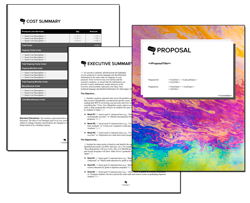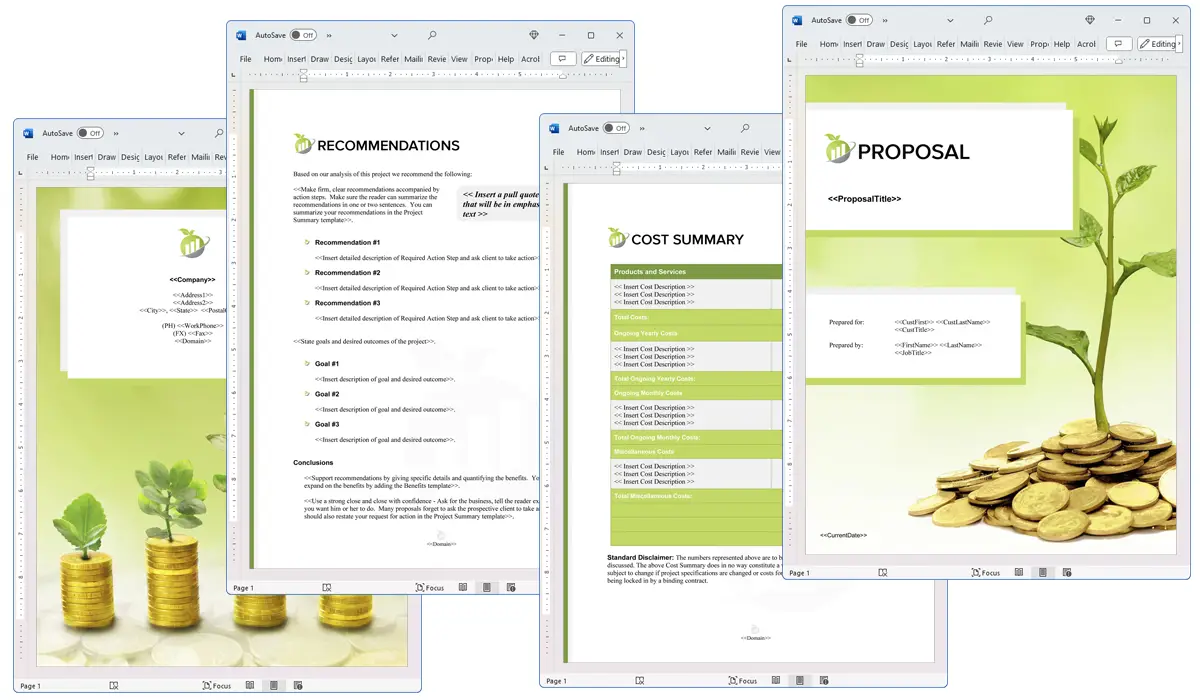What is the File Plan chapter used for?
Proposal Kit Professional Bundle adds more design themes, all six Contract Packs,
a project management library, and Expert Edition software.

Illustration of Proposal Pack Events #5
We include this File Plan chapter template in every Proposal Pack, along with thousands more. You assemble this chapter with others in various combinations to create custom-tailored business proposals, plans, reports, and other documents. Proposal Packs apply custom visual designs to the templates, giving the final documents a consistent professional finish.
 DOWNLOADABLE, ONE-TIME COST, NO SUBSCRIPTION FEES
DOWNLOADABLE, ONE-TIME COST, NO SUBSCRIPTION FEES
Overview of the File Plan Chapter
The File Plan chapter plays an important role within the broader scope of business proposals created using Proposal Kit. This chapter is designed to provide a structured approach to document and record management within a company. Effective management of documents ensures that critical information is organized, easily accessible, and securely maintained throughout its lifecycle. The File Plan chapter lays the groundwork for these objectives by establishing a controlled vocabulary or taxonomy, which is important for categorizing and retrieving documents efficiently.
How is the File Plan Chapter Used?
When used in a business proposal, the File Plan chapter is used to demonstrate to potential clients or project stakeholders how documents will be managed during and after the project. This includes detailing the methods and systems that will be used for document storage, retrieval, archiving, and destruction. By including this chapter in a proposal, businesses can show their commitment to efficient and secure document management, which can be a reassuring factor for clients concerned about confidentiality and compliance issues.
What is Included in the File Plan Chapter?
The File Plan chapter typically includes several key elements:
- Definition of Taxonomy: This section describes the controlled vocabulary that will be used to categorize documents.
- Document Lifecycle Management: Outlines the processes involved in the handling of documents from creation to destruction.
- Access Controls: Details who will have access to various types of documents and how access is controlled.
- Storage Solutions: Explains the physical and/or digital storage solutions that will be used.
- Retention Schedule: Specifies how long different types of documents are to be kept before they are archived or destroyed.
Use Case Examples for the File Plan Chapter
- Government Contract Proposals: Demonstrating compliance with federal records management requirements.
- Healthcare Industry Proposals: Outlining how patient records are handled securely and in compliance with HIPAA regulations.
- Legal Services Proposals: Detailing the management of sensitive legal documents to maintain client confidentiality.
- Construction Project Proposals: Explaining the management of project documentation such as contracts, blueprints, and compliance certificates.
- IT Services Proposals: Showcasing the methods for managing software documentation and project deliverables.
Key Takeaways
- The File Plan chapter is important for demonstrating organized and secure document management in business proposals.
- It helps businesses show their adherence to industry standards and regulatory requirements concerning document handling.
- This chapter includes details about the taxonomy used for document categorization, lifecycle management, access controls, storage, and retention.
- Use cases vary across industries but commonly focus on compliance, security, and efficiency in document management.
- Including a well-defined File Plan chapter can significantly enhance the credibility of a proposal, particularly in sectors where document handling is critical.

Illustration of Proposal Pack Environmental #6
 What Our Clients Say
What Our Clients SayYour proposal product was great, very easy to use and saved me a ton of time!"
 4.7 stars, based on 849 reviews
4.7 stars, based on 849 reviewsRelated Chapters
Document Layouts Using the File Plan Chapter

The File Plan chapter and other chapters are integrated into a Word document as illustrated here in the Proposal Pack Accounting #2 design theme. There are hundreds of design themes available, and every design theme includes the File Plan chapter template.
A proper business proposal will include multiple chapters. This chapter is just one of many you can build into your proposal. We include the complete fill-in-the-blank template in our Proposal Pack template collections. We also include a library of sample proposals illustrating how companies in different industries, both large and small, have written proposals using our Proposal Packs. This template will show you how to write the File Plan.
We include a chapter library for you to build from based on your needs. All proposals are different and have different needs and goals. Pick the chapters from our collection and organize them as needed for your proposal.
Using the Proposal Pack template library, you can create any business proposal, report, study, plan, or document.
The Wizard software includes an AI Writer, which will write the content of this and any other chapter of your document. Use the AI Writer to do the heavy lifting, writing the first draft of your proposal or business document in minutes.
 Ian Lauder has been helping businesses write their proposals and contracts for two decades. Ian is the owner and founder of Proposal Kit, one of the original sources of business proposal and contract software products started in 1997.
Ian Lauder has been helping businesses write their proposals and contracts for two decades. Ian is the owner and founder of Proposal Kit, one of the original sources of business proposal and contract software products started in 1997.By Ian Lauder
 Published by Proposal Kit, Inc.
Published by Proposal Kit, Inc.


 Cart
Cart
 Facebook
Facebook YouTube
YouTube Bluesky
Bluesky Search Site
Search Site